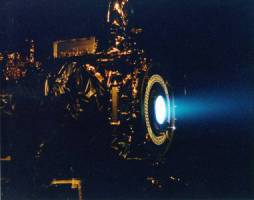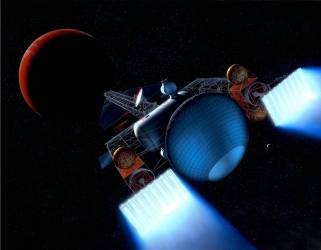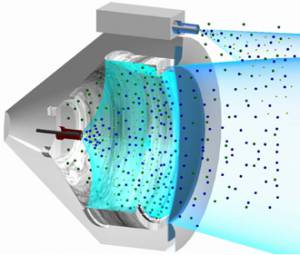Electric or ion propulsion is the newest propulsion system that NASA has put into successful operation. The Deep Space 1 mission used the ion engine as its primary propulsion system and tested its capabilities for the 21st century. Its advantages over conventional propulsion include lower fuel weight, much higher fuel efficiency, and longer operational life. The NSTAR engine that operated on Deep Space 1 used electromagnetic forces to accelerate positively charged xenon ions through a potential difference. The potential difference was produced by circular electromagnets that pushed the xenon ions resulting in an ion stream that exited at the exhaust end of the spacecraft at high speed. The thrust output of the ion engine is very small, but the fuel efficiency is an order of a magnitude higher than chemical rockets. In propulsion systems, fuel efficiency is technically referred to as specific impulse or the amount of momentum increase for a given amount of fuel consumption. Given a sufficiently long mission time, an ion engine is able to achieve speeds far greater than any chemical rocket. The use of the ion engine will undoubtedly be the best choice of propulsion for space probes in the 21st century.
Introduction
Ion propulsion is a new technology that has been fully tested and implemented in experimental spacecraft. Research into this unique type of propulsion began in the 1950s. Commonly referred to as electric propulsion, ion propulsion systems are a particular type of electric propulsion. The most noticeable difference between a fully loaded conventional rocket and an electric propulsion system would be the mass of fuel required to produce thrust. While conventional chemically fueled rockets require millions of kilograms of propellant, ion propulsion systems require only a miniscule amount of propellant by comparison [1]. Also, all electric engines are highly efficient and reliable, making them excellent choices for long, unattended operation. One of the most applicable areas for electric propulsion is space exploration. The spacecraft designated Deep Space 1 was launched by NASA on October 24, 1998. The purpose of this spacecraft was to test 12 different experimental technologies; one of which was the ion engine developed under the NASA Solar Electric Propulsion Technology Application Readiness program, or NSTAR program. The engine was, therefore, referred to as the NSTAR engine. The mission was an unprecedented success and spurred further study into the new technologies that may arise through ion propulsion [2].
Under most circumstances, operations in space can only be accomplished by imparting some sort of speed gain or loss on a spacecraft. There are two possibilities for this action: either the mass of the spacecraft is decreased or the exhaust speed provided by a thruster is increased [3] (see Fig. 1). A chemically fueled rocket does both of these tasks simultaneously. As the exhaust speed is increased, fuel is being consumed, and the weight is being reduced. The force imparted by this exhaust speed is called the thrust.
Design of the NSTAR engine
The concept behind the ion propulsion system is that ionized particles are used to create thrust. The thrust is produced through a series of stages. First, electrical power is generated from the solar arrays, which convert light energy from the sun into electrical energy that powers the navigation, communication, and propulsion systems. The electrical power that is sent to the propulsion system is directed to two different locations. Some electricity is used to heat a metallic plate on which the solid fuel is attached. The heat causes the solid fuel to be converted to a gaseous fluid composed of neutrally charged atoms. These neutral atoms are then released into a cylindrical, electromagnet-ringed chamber where they float freely because they are uncharged. The rest of the electricity sent to the propulsion system charges the electromagnets. The current flowing through the electromagnets produces a magnetic field that pushes positively charged particles perpendicularly to the direction of current flow.
In a separate tank, negatively charged electrons are forced into the cylindrical chamber where they are accelerated toward the neutral atoms by the magnetic field. This acceleration causes them to bombard the neutral atoms at high speeds. The magnets also redirect the electrons near the neutral atoms in order to increase the efficiency of the ionization [4]. The bombardment knocks one electron off of a neutral atom, causing a positive charge to be built up within the chamber [5]. Then, a potential difference pushes the positively charged ions out as exhaust. A potential difference is essentially an electric field acting between the two ends of the chamber that will push positively charged particles toward the negatively charged end of the chamber. The end of the chamber closest to the main body of the spacecraft is a positively charged mesh grid, and the exhaust end is a negatively charged mesh grid. The potential difference between the two accelerates ions through the chamber since the positive grid repels the positive ions and the negative grid attracts the positive ions. The negatively charged grid does not stop the ions after they exit the exhaust end of the spacecraft because the ions are traveling at such a high velocity. The figure below illustrates the charges and directions of the positive ions and the mesh grids at the two ends of the chamber [5] (Fig. 2).
However, the process does not end here. Since positive charge is being expelled leaving excess negative charge on the spacecraft, an immediate build up of negative charge develops on the spacecraft. Left unchecked, this would cause disastrous effects to other electrical instrumentation and experiments because the stray electrons may potentially interact with flowing current on other parts of the spacecraft. Therefore, most of the excess negative electrons that are knocked off the atoms are collected into another separate chamber, called a neutralizer, and forced out into the ion stream as shown in the diagram below. This final step produces a neutral stream of particles that has no chance of damaging other nearby spacecraft or onboard instrumentation [6].
The thrust produced by the particle stream is very small, comparable to the amount of downward force exerted by a single sheet of paper lying on a table, since the mass of each particle is small. However, each step in the process occurs continuously, causing a constant acceleration of the spacecraft [7].
Implementation of the Ion Engine in Deep Space 1
Deep Space 1 was NASA’s first demonstration of the research into advanced technologies being performed by the New Millennium Program. It was launched from Cape Canaveral atop a Delta II rocket on October 24, 1998. Carried on board Deep Space 1 were 11 separate experimental technologies in addition to the NSTAR ion propulsion system [2]. Eighty-two kilograms of xenon gas propellant were used specifically to fuel the ion engine. Xenon was chosen for two main reasons. First, xenon is an inert gas, so it is not harmful to the internal environment of the spacecraft; it will not corrode or interfere with other subsystems in any way. In the past, cesium or mercury metallic elements were used as propellants because they are more readily ionized, giving them greater efficiency when compared to xenon. However, mission planners and spacecraft designers were concerned about using metallic propellants onboard the already high-risk spacecraft [3]. The second reason xenon was chosen is because it is about four times more heavy than Earth’s atmospheric gas, giving it a large enough mass to produce the effective force needed to cause the thrust event.
The xenon ions were accelerated through a potential difference of 1280 volts and attained a speed of 31.5 kilometers per second before exiting the spacecraft. The force this produced was still very small at maximum power usage, but the NSTAR engine operated for a record 16,265 hours while the expected operational life was only 14,000 hours. It was also the first spacecraft to strictly rely on ion propulsion as its sole source of thrust [8]. Overall, the mission was an unprecedented success since it not only accomplished its mission and extended mission objectives but also several others as well. Fly-bys of the asteroid Braille and comet Borrely, for example, both returned excellent photographs and telemetry. After the extended mission was accomplished, the mission planners decided to test the NSTAR engine in modes of operation that were considered either too risky or inappropriate for a primary mission. The additional rigorous testing of the engine was possible since only a mere 22 of the original 82 kilograms of the xenon propellant had been consumed by the end of the extended mission [9]. The tested reliability and performance of the NSTAR ion engine on the Deep Space 1 spacecraft made it a clear choice for propulsion in the 21st century.
Effectiveness of Electric Ion Propulsion
The effectiveness of electric propulsion depends largely on the mission requirements for a particular operation. Fuel efficiency, or more accurately, specific impulse, plays a primary role in the effectiveness of any engine.
Specific impulse is a measure of the amount of change in momentum for the mass of fuel expended. An engine with a high specific impulse does not need as much fuel to reach a given velocity as an engine with a low specific impulse. In this way electric propulsion has a very distinct advantage over chemical propulsion since the specific impulse of a chemical rocket may range anywhere from 100 to 500 seconds while an ion rocket has a specific impulse of 30,000 to 50,000 seconds [7]. This is what allowed the NSTAR engine to operate as long as it did.
For missions that require massive amounts of acceleration in a short period of time, like launching a payload from sea level to low earth orbit, the use of electric propulsion would be impossible. At present, chemical rockets would be best suited for such missions because they are able to produce the rapid acceleration that is required. If the mission duration for a particular objective were much longer, however, electric propulsion would be a better alternative [10]. Electric propulsion is able to provide constant thrust, and consequently, a constant acceleration because the ion stream continuously produces a reaction that pushes the spacecraft in the direction of travel. Chemical rockets, on the other hand, thrust for only a short length of time, and then coast along their set path, which will not change unless fuel is expended at a high rate to first slow velocity in one direction and then to increase velocity in the new direction. Electric propulsion allows for easy direction changes because it only requires the changing of the ion stream direction at the same rate of thrust. Chemical rockets are unable to provide any type of long-term constant thrust [3]. The NSTAR engine on Deep Space 1 operated for 22 months with only a few short interruptions and increased the velocity of the spacecraft by 12,700 kilometers per hour [2]. This type of velocity increase would not have been possible if chemical propellants were used because of limitations on the amount of fuel the spacecraft can carry.
Conclusion
The electric ion propulsion system is the next step in mankind’s forward progress into space exploration. NASA’s goal of the New Millennium Program was to test new technologies that could be used in the 21st century. In the near future, electric propulsion has the potential to fuel interplanetary manned missions to Mars and possibly even missions to the moons of Jupiter [2]. The simple fact that the fuel efficiency of electric propulsion is so great makes it ideal for communication satellites, an area in which electric thrusters are already being widely used. Still, electric propulsion is only a small step forward. On the grand scheme of space exploration, new technologies that would cause the seemingly infallible principles of physics to break down would have to be invented in order for local interstellar travel to be possible.







